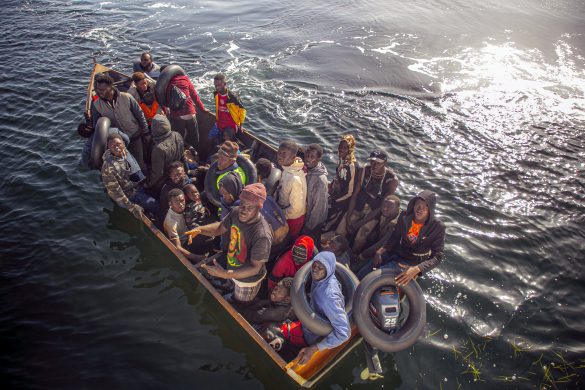To millioner mennesker i Guatemala, Honduras, Nicaragua og El Salvador er truet af fødevaremangel på grund af tørke. Det skønnes at majshøsten er reduceret med 80 procent og bønnehøsten med 63 procent.
BRUXELLES, 11. October 2014 (ECHO): In view of the the harsh draught which has plaqued Central America, five of ECHO’s (EU Kommissionens kontor for humanitær bistand, red.) regional humanitarian partners have come together to jointly express their concern of the implications to the region’s populations.
Our colleagues at Oxfam, Cooperazione Internazionale (COOPI), Action Against Hunger, Save The Children, and Goal Honduras are calling for action – now:
Den tørre korridor
Staple crop producers in the so-called ‘Corredor Seco’ (Dry Corridor) of the Central American, which spans Guatemala, Honduras, Nicaragua and El Salvador, have been severely affected by a drought caused by the ‘El Niño’ phenomenon.
It has the most prolonged drought in 40 years, according to the regional meteorological services.
Subsistence agriculture in the Dry Corridor, based on maize and beans, is highly vulnerable to climatic phenomena such as drought since the crops are planted in dry and non-irrigated soil.
Subsistenslandbrug og landarbejdere
The Dry Corridor region has the highest levels of food insecurity in Central America because thousands of families depend on subsistence farming and on agricultural daily labour, both of which have been hard hit in the last three years by the drought and by the coffee rust.
The coffee rust plague affected 70 per cent of the region’s coffee plantations and consequently dramatically reduced demand for day labourers.
Although the drought has had differentiated impacts in each of the four countries, overall more than 500 000 families (over 2 million people) are facing a situation of food insecurity due to losses in agricultural production and livestock as well as the loss of income from daily labour.
We come from five NGO working in the region, long time partners of ECHO, and we are deeply worried.
En halv million børn sulter
The effects of the drought in Guatemala have reached unprecedented peaks. The Food Security Secretariat (SESAN) estimates maize losses at 80 per cent and bean losses at 63 per cent, affecting over 250 000 vulnerable families (1.4 million people), with half a million children suffering from hunger.
At the same time, the price of beans in El Salvador, Honduras and Nicaragua has doubled since last year.
“We’ve seen severe changes in the children here. Children are malnourished. Some severely. We have also seen the elderly growing more tired because of the lack of food,” says Esperanza, a coffee picker from El Salvador who now can only work 15 days of the year because the coffee rust has devastated the crop around her community.
Katastrofealarm i Guatamala
We’ve been to the field assessing the damage and the prospects for the future and the situation does not look good. The situation is particularly worrying in Guatemala, which ranks 5thin the world in infant malnutrition and where the State of Calamity has been declared by the Government.
”We’ve suffered droughts before but never like this one. Lack of rain used to last 20 or 25 days. This year was the toughest. We’ve gone through 45 days without rain. Our production for family consumption has been halved,” Guatemalan farmer Pascual Ramírez told us. “It’s even worse because there are no jobs anywhere. Because of the drought, there are no crops and our children are hungry,” another farmer told us.
Our studies show that in communities like Chiquimula, the level of food consumption of nearly 58% of the families surveyed is poor.
Prisen på majs fordoblet
Adding to this, maize prices have doubled and continue to rise. Thus families are facing huge difficulties in accessing food, since many households have no income opportunities apart from crops.
Impossibly high prices together with an alarming drop in income and food production: this is the terrible equation thousands are facing.
Thousands of families have been forced to resort to desperate means in order to survive, like reducing the number of meals per day or the portions, and selling family assets, which only makes them poorer and even more vulnerable.
Kvinder rammes gennemsnitligt hårdere
Drought has a particularly strong impact on female producers, due to gaps in access to land and other livelihoods.
Women farmers on average have 13 per cent less land than male farmers for maize and over 50 per cent less for beans: this means that female-headed households have less food reserves than male-headed households (1,3 months less), putting their food and nutritional security at great risk.
Not only the current situation is alarming. The future prospects are, too.
Our studies show that only 32 per cent of households will be able to plant crops during the next sowing cycle.
This means that the rest – nearly 70 per cent of the farmers affected by the drought – will not be able to harvest until August 2015.
Less than 10 per cent of these households have access to government social protection programs transferring them some cash to survive.
Initiatives like the Drought Resilience programme funded by the EU’s department of Humanitarian Aid and Civil Protection, are very much needed.
With a funding of 3.5 million euros in the last 4 years, ECHO and its partners have helped communities along the Dry Corridor to take measures than increase their ability to cope to face drought.
“Det er en humanitær nødsituation“
But the worst drought in four decades demands an additional response. There is a humanitarian emergency and the local resources are not enough to address it. On September 26th, Guatemala and Honduras have asked for international help.
The food insecurity situation requires immediate action to facilitate access to food for the most vulnerable groups; to identify and treat undernourished children; and to support the 2015 agricultural production to break this cycle so that the families affected by drought can recover their livelihoods.
Af Iván Aguilar (Oxfam Guatemala), Saskia Carusi (COOPI), Miguel Ángel García (Action Against Hunger Central America), Roberto Cabrera (Save The Children), Bernard McCaul (Goal Honduras)















